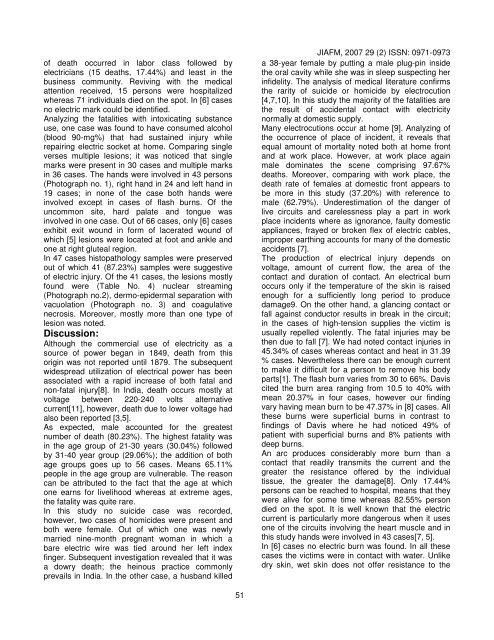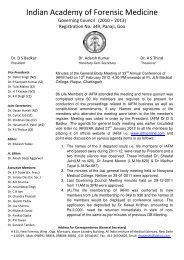Journal of Indian Academy of Forensic Medicine (JIAFM)
Journal of Indian Academy of Forensic Medicine (JIAFM)
Journal of Indian Academy of Forensic Medicine (JIAFM)
Create successful ePaper yourself
Turn your PDF publications into a flip-book with our unique Google optimized e-Paper software.
<strong>of</strong> death occurred in labor class followed by<br />
electricians (15 deaths, 17.44%) and least in the<br />
business community. Reviving with the medical<br />
attention received, 15 persons were hospitalized<br />
whereas 71 individuals died on the spot. In [6] cases<br />
no electric mark could be identified.<br />
Analyzing the fatalities with intoxicating substance<br />
use, one case was found to have consumed alcohol<br />
(blood 90-mg%) that had sustained injury while<br />
repairing electric socket at home. Comparing single<br />
verses multiple lesions; it was noticed that single<br />
marks were present in 30 cases and multiple marks<br />
in 36 cases. The hands were involved in 43 persons<br />
(Photograph no. 1), right hand in 24 and left hand in<br />
19 cases; in none <strong>of</strong> the case both hands were<br />
involved except in cases <strong>of</strong> flash burns. Of the<br />
uncommon site, hard palate and tongue was<br />
involved in one case. Out <strong>of</strong> 66 cases, only [6] cases<br />
exhibit exit wound in form <strong>of</strong> lacerated wound <strong>of</strong><br />
which [5] lesions were located at foot and ankle and<br />
one at right gluteal region.<br />
In 47 cases histopathology samples were preserved<br />
out <strong>of</strong> which 41 (87.23%) samples were suggestive<br />
<strong>of</strong> electric injury. Of the 41 cases, the lesions mostly<br />
found were (Table No. 4) nuclear streaming<br />
(Photograph no.2), dermo-epidermal separation with<br />
vacuolation (Photograph no. 3) and coagulative<br />
necrosis. Moreover, mostly more than one type <strong>of</strong><br />
lesion was noted.<br />
Discussion:<br />
Although the commercial use <strong>of</strong> electricity as a<br />
source <strong>of</strong> power began in 1849, death from this<br />
origin was not reported until 1879. The subsequent<br />
widespread utilization <strong>of</strong> electrical power has been<br />
associated with a rapid increase <strong>of</strong> both fatal and<br />
non-fatal injury[8]. In India, death occurs mostly at<br />
voltage between 220-240 volts alternative<br />
current[11], however, death due to lower voltage had<br />
also been reported [3,5].<br />
As expected, male accounted for the greatest<br />
number <strong>of</strong> death (80.23%). The highest fatality was<br />
in the age group <strong>of</strong> 21-30 years (30.04%) followed<br />
by 31-40 year group (29.06%); the addition <strong>of</strong> both<br />
age groups goes up to 56 cases. Means 65.11%<br />
people in the age group are vulnerable. The reason<br />
can be attributed to the fact that the age at which<br />
one earns for livelihood whereas at extreme ages,<br />
the fatality was quite rare.<br />
In this study no suicide case was recorded,<br />
however, two cases <strong>of</strong> homicides were present and<br />
both were female. Out <strong>of</strong> which one was newly<br />
married nine-month pregnant woman in which a<br />
bare electric wire was tied around her left index<br />
finger. Subsequent investigation revealed that it was<br />
a dowry death; the heinous practice commonly<br />
prevails in India. In the other case, a husband killed<br />
51<br />
<strong>JIAFM</strong>, 2007 29 (2) ISSN: 0971-0973<br />
a 38-year female by putting a male plug-pin inside<br />
the oral cavity while she was in sleep suspecting her<br />
infidelity. The analysis <strong>of</strong> medical literature confirms<br />
the rarity <strong>of</strong> suicide or homicide by electrocution<br />
[4,7,10]. In this study the majority <strong>of</strong> the fatalities are<br />
the result <strong>of</strong> accidental contact with electricity<br />
normally at domestic supply.<br />
Many electrocutions occur at home [9]. Analyzing <strong>of</strong><br />
the occurrence <strong>of</strong> place <strong>of</strong> incident, it reveals that<br />
equal amount <strong>of</strong> mortality noted both at home front<br />
and at work place. However, at work place again<br />
male dominates the scene comprising 97.67%<br />
deaths. Moreover, comparing with work place, the<br />
death rate <strong>of</strong> females at domestic front appears to<br />
be more in this study (37.20%) with reference to<br />
male (62.79%). Underestimation <strong>of</strong> the danger <strong>of</strong><br />
live circuits and carelessness play a part in work<br />
place incidents where as ignorance, faulty domestic<br />
appliances, frayed or broken flex <strong>of</strong> electric cables,<br />
improper earthing accounts for many <strong>of</strong> the domestic<br />
accidents [7].<br />
The production <strong>of</strong> electrical injury depends on<br />
voltage, amount <strong>of</strong> current flow, the area <strong>of</strong> the<br />
contact and duration <strong>of</strong> contact. An electrical burn<br />
occurs only if the temperature <strong>of</strong> the skin is raised<br />
enough for a sufficiently long period to produce<br />
damage9. On the other hand, a glancing contact or<br />
fall against conductor results in break in the circuit;<br />
in the cases <strong>of</strong> high-tension supplies the victim is<br />
usually repelled violently. The fatal injuries may be<br />
then due to fall [7]. We had noted contact injuries in<br />
45.34% <strong>of</strong> cases whereas contact and heat in 31.39<br />
% cases. Nevertheless there can be enough current<br />
to make it difficult for a person to remove his body<br />
parts[1]. The flash burn varies from 30 to 66%. Davis<br />
cited the burn area ranging from 10.5 to 40% with<br />
mean 20.37% in four cases, however our finding<br />
vary having mean burn to be 47.37% in [8] cases. All<br />
these burns were superficial burns in contrast to<br />
findings <strong>of</strong> Davis where he had noticed 49% <strong>of</strong><br />
patient with superficial burns and 8% patients with<br />
deep burns.<br />
An arc produces considerably more burn than a<br />
contact that readily transmits the current and the<br />
greater the resistance <strong>of</strong>fered by the individual<br />
tissue, the greater the damage[8]. Only 17.44%<br />
persons can be reached to hospital, means that they<br />
were alive for some time whereas 82.55% person<br />
died on the spot. It is well known that the electric<br />
current is particularly more dangerous when it uses<br />
one <strong>of</strong> the circuits involving the heart muscle and in<br />
this study hands were involved in 43 cases[7, 5].<br />
In [6] cases no electric burn was found. In all these<br />
cases the victims were in contact with water. Unlike<br />
dry skin, wet skin does not <strong>of</strong>fer resistance to the









